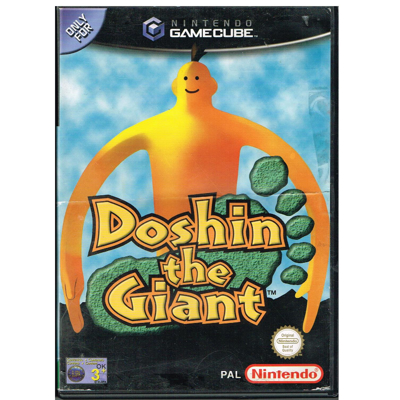DOSHIN THE GIANT GAMECUBE
DOSHIN THE GIANT GAMECUBE
Doshin the Giant is a Nintendo god simulation game for the Nintendo 64DD and GameCube. It was originally released in Japan on December 1, 1999 as a launch title for the 64DD, for which a soundtrack by Tatsuhiko Asano was released on CD by Media Factory, early the next year. Both of these received positive reviews. An expansion was released five months later called Kyojin no Doshin Kaihō Sensen Chibikko Chikko Daishūgou, which takes a very different perspective of the game, featuring short animated clips that the player can unlock after playing the original game. Doshin the Giant was later released and upgraded graphically for the GameCube and released in Japan on March 14, 2002 and Europe on September 20, 2002. The re-release received mostly positive reviews.
The game opens on an island called Barudo, with a spoken narration, by an island native. This man, named Sodoru[2] who wears a mask on his face, tells the legend of a giant that rises out of the sea as the morning sun rises. As he tells the player this, Doshin, a yellow giant appears from out of the water.
The player then takes control of the giant. Sodoru then tells the player what the other inhabitants of the island want such as trees or hills raised and lowered. He then suggests helping the people, for which they will reward the giant with love, and might build a monument to it. Sodoru then suggests that the giant help bring the four tribes together. It takes Doshin many days to do this, and at the end of each day as the sun sets he returns to the sea. Finally, when every possible combination of tribes has been reached, the islanders then build one final monument called the Tower of Babel, which causes the island and Doshin to sink into the sea, thus destroying everyone. However, the next day, a new island appears at sunrise in the shape of Doshin himself, with two members of each of the tribes on it as before. Doshin then walks out onto the island again and the story continues.
The GameCube version, however, has one additional ending with the islanders not building a monument this time, but instead a large rocket that blasts them up into space. This ending has similarities with the beginning of Nintendo's Pikmin, which starts with a crashing ship and the survivor meeting three different colored plant type creatures
As a god game, Doshin the Giant's gameplay revolves around typical god-like abilities and tasks, such as altering the geography, managing natural disasters or answering prayers from simulated worshippers. Its designer Kazutoshi Iida has described it as "Populous meets Mario".
The player controls the Doshin as he tries to help, or hinder the islands inhabitants. Doing so causes the villagers to release love or hate, which Doshin absorbs. The two feelings cancel each other out, but if he gets enough of one type, he will grow in size. Doshin is the Love Giant, a yellow, featureless giant with a happy face and a few strands of hair. He is a benevolent, helpful being who, with his good actions, earns love from his people and increases in size (only for that day; by the next day, he is back to normal size). He can pick up people trees and other such things. Doshin can transform at will into his evil alter ego Jashin, the Hate Giant. In the GameCube version, he has wings and clawed feet and inspires Hate monuments that are slightly different from the Love monuments Doshin can earn.Jashin is known to be a destructive force to the natives, the exact opposite to Doshin's nature. With his bad actions, people show him their dislike, and he increases in size. The only thing the two giants have in common is that both have an outie belly button. Although he cannot pick up things, he can send streams of fire across the land, destroying structures in their way. Doshin and Jashin can both raise and lower terrain.
The four native tribes on the island are separated with the color of their clothing (red, green, yellow, blue). The female natives are dressed in a sleeveless, uni-colored gown of their tribe's color. The male natives wear a kilt and hat of their tribe's color, but remain shirtless, also showing outie belly buttons. In the GameCube version the people also raise farm animals, and there are fish in the water. There are several threats that also endanger the villagers, such as tornadoes, volcanoes, fires, being crushed by Doshin, and even jealous tribe members named "Naughties."
Other features of the game include the following: an album of photographic snapshots of the gameplay itself; and a monument gallery, where the player can look at the monument close up and find out information about it. In the GameCube version, after completing the game, a "New Map" option is unlocked. This option has various islands with different themed layouts and textures.
Developer Kazutoshi Iida notes "the sheer simplicity of the user-interface, as the game can be played without numbers or letters." He added, "Mr. Shigeru Miyamoto from Nintendo has said that computer games incorporate a world-wide common language, and 'Doshin' illustrates this very clearly."
KOMPLETT I BOX


